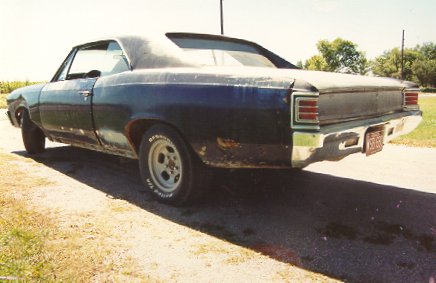 This is a 1967 Chevelle Malibu that I bought during my Senior
year in highschool. Yeah, I know, the paint is shot, its got some
rust, the fender is dented, etc, etc. But those wheels and tires
aren't too bad...
This is a 1967 Chevelle Malibu that I bought during my Senior
year in highschool. Yeah, I know, the paint is shot, its got some
rust, the fender is dented, etc, etc. But those wheels and tires
aren't too bad...
Well, looking back, I suppose it's only natrual that I would grow up to have at least a passing interest in electricity and electronics. Judging from my still somewhat vivid memory of me (three years old at the time) sticking my mother's car keys into an electrical outlet at the doctors office. (I seem to remember thinking that the little vertical slots looked like key slots and I was curious to see what was behind the little locked door!)
Throughout childhood, I had accumulated no less than a dozen of those "101 projects with electricity" kits from Radio Shack. I put in countless hours wiring circuits, winding coils, checking lights, etc., etc. and more or less most of the projects worked. That's not to say I haven't smoked my fair share of transformers, LED's, IC's, resistors, and a few capacitors to boot.
After graduating from college in December of 1995, with a Bachelor of Science Degree in Chemistry and minors in Manufacturing Technology and Plastics Technology, I began working for a small research and testing lab in southern Missouri. My main duty was performing Metallurgical Failure analysis along with chemical and mechanical testing of metals and other materials. Being such a small lab, word of my interest in electronics spread and I soon found my self doing the electronics testing as well. This involved such things as battery and lightbulb lifetime testing, lightbulb luminance studies, and computerized data aquisition.
But
in February 1998, I decided it was time to move on--That is when I took
my current job at a research and testing lab in Kansas. So, here
I am. My job description has somewhat narrowed in focus, but I still
have plenty of time to pursue my interests away from work.
Some Projects over the Years
 This is a 1967 Chevelle Malibu that I bought during my Senior
year in highschool. Yeah, I know, the paint is shot, its got some
rust, the fender is dented, etc, etc. But those wheels and tires
aren't too bad...
This is a 1967 Chevelle Malibu that I bought during my Senior
year in highschool. Yeah, I know, the paint is shot, its got some
rust, the fender is dented, etc, etc. But those wheels and tires
aren't too bad...
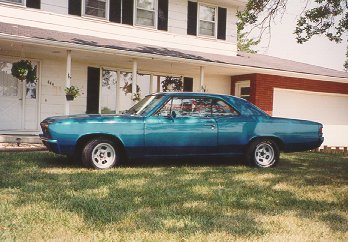 This
is the end result after about a year of blood, sweat and tears. Luckily,
the engine and transmission were in great shape when I bought the car.
Most of the work I did was body work, paint, and interior. The old Chevelle
is gone, but I found a nice Corvette to satisfy the "need for speed"!
This
is the end result after about a year of blood, sweat and tears. Luckily,
the engine and transmission were in great shape when I bought the car.
Most of the work I did was body work, paint, and interior. The old Chevelle
is gone, but I found a nice Corvette to satisfy the "need for speed"!
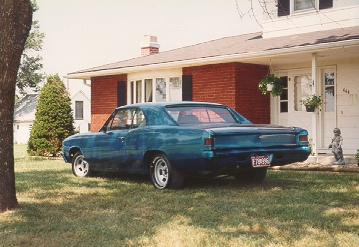 1967 Chevell Malubu
1967 Chevell Malubu
Engine:
283 cu in V-8, bored .030 over
flat tappet cam .491" lift, 283* duration
single Holley 600 cfm carb
Transmission: Turbo-Hydramatic 350
Interior:
Dove gray vinyl w/ raised accents
Power windows, locks, brakes, and steering
Paint:
1992 Aqua-metallic monochrome
Tires:
Pirelli P205 60 R14 front
BF Goodrich P255 60 R14 rear
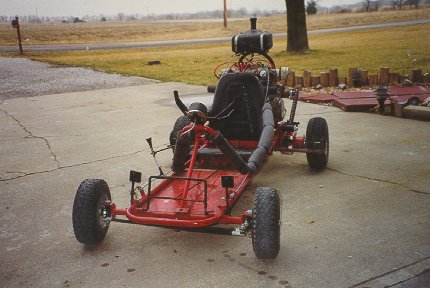 This is a little demon I built back in 1995. I found
this old go-cart with a blown 3 HP Briggs & Straton engine and decided
it would be a perfect candidate for something a little bigger. If
you squint and look closely, you can just see the four orange spark plug
wires sprouting from behind the seat! They supply the 350cc 4-cylinder
Honda with ignition power. The 'lil Honda also sports electric start,
quad carburators and a 5 speed tranny. The designed gear ratios should
have put the top speed at about 120 MPH @ 5,000 RPM in fifth gear. (YIKES!!)
Unfortunately at about 50 MPH the little tires would stand up off of the
rim and rub the brake pads. I had planned to use a disk brake, but
the disk had a larger diameter than the tires!
This is a little demon I built back in 1995. I found
this old go-cart with a blown 3 HP Briggs & Straton engine and decided
it would be a perfect candidate for something a little bigger. If
you squint and look closely, you can just see the four orange spark plug
wires sprouting from behind the seat! They supply the 350cc 4-cylinder
Honda with ignition power. The 'lil Honda also sports electric start,
quad carburators and a 5 speed tranny. The designed gear ratios should
have put the top speed at about 120 MPH @ 5,000 RPM in fifth gear. (YIKES!!)
Unfortunately at about 50 MPH the little tires would stand up off of the
rim and rub the brake pads. I had planned to use a disk brake, but
the disk had a larger diameter than the tires!
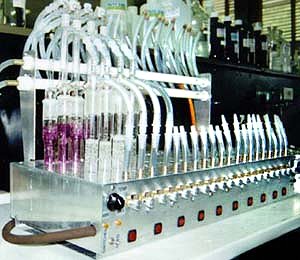 This
is a 20 position heated extraction station for removing cyanide from soil
samples. The idea is to dissolve the soil in an acidic mixture (the
purple tubes at the back) which turns the cyanide compounds into HCN -
hydrogen cyanide gas. The gas then flows to the tubes in front (clear
liquid) and is turned into NaCN - sodium cyanide (solid). The setup
uses a couple of 555 Timers, full solid state switching, 10 - 400watt heaters
and can run in manual or automatic mode.
This
is a 20 position heated extraction station for removing cyanide from soil
samples. The idea is to dissolve the soil in an acidic mixture (the
purple tubes at the back) which turns the cyanide compounds into HCN -
hydrogen cyanide gas. The gas then flows to the tubes in front (clear
liquid) and is turned into NaCN - sodium cyanide (solid). The setup
uses a couple of 555 Timers, full solid state switching, 10 - 400watt heaters
and can run in manual or automatic mode.
Another
project (sorry, no pix) used the shop arc welder and some 1/2" diameter
tungsten electrodes to melt metal shavings into solid slugs so we could
do chemical analysis on the slug. The "remelting furnace" used 660
amps at 40 volts (26,400 watts) to melt the metal in a water cooled copper
crucible under an inert atmosphere of argon. This used mostly mechanical
relays, and motorized timers and had a fully automatic 5 step process.